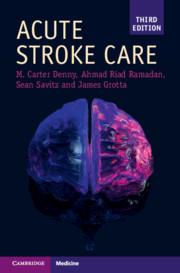Book contents
- Acute Stroke Care
- Acute Stroke Care
- Copyright page
- Contents
- Preface to the Third Edition
- Abbreviations
- Chapter 1 Stroke in the Emergency Department
- Chapter 2 What to Do First
- Chapter 3 Ischemic Stroke
- Chapter 4 Stroke Radiology
- Chapter 5 Intravenous Thrombolysis
- Chapter 6 Endovascular Therapy
- Chapter 7 Neurological Deterioration in Acute Ischemic Stroke
- Chapter 8 Ischemic Stroke Etiology and Secondary Prevention
- Chapter 9 Transient Ischemic Attack
- Chapter 10 Less Common Causes of Stroke
- Chapter 11 Cerebral Venous Sinus Thrombosis
- Chapter 12 Intracerebral Hemorrhage
- Chapter 13 Subarachnoid Hemorrhage
- Chapter 14 Organization of Stroke Care
- Chapter 15 Stroke Rehabilitation
- Chapter 16 Transition to Outpatient Stroke Care
- Book part
- Further In-Depth Reading
- Index
- Plate Section (PDF Only)
- References
Chapter 4 - Stroke Radiology
Published online by Cambridge University Press: 28 October 2019
- Acute Stroke Care
- Acute Stroke Care
- Copyright page
- Contents
- Preface to the Third Edition
- Abbreviations
- Chapter 1 Stroke in the Emergency Department
- Chapter 2 What to Do First
- Chapter 3 Ischemic Stroke
- Chapter 4 Stroke Radiology
- Chapter 5 Intravenous Thrombolysis
- Chapter 6 Endovascular Therapy
- Chapter 7 Neurological Deterioration in Acute Ischemic Stroke
- Chapter 8 Ischemic Stroke Etiology and Secondary Prevention
- Chapter 9 Transient Ischemic Attack
- Chapter 10 Less Common Causes of Stroke
- Chapter 11 Cerebral Venous Sinus Thrombosis
- Chapter 12 Intracerebral Hemorrhage
- Chapter 13 Subarachnoid Hemorrhage
- Chapter 14 Organization of Stroke Care
- Chapter 15 Stroke Rehabilitation
- Chapter 16 Transition to Outpatient Stroke Care
- Book part
- Further In-Depth Reading
- Index
- Plate Section (PDF Only)
- References
Summary
Non-contrast CT (NCCT) of the head remains the standard procedure for the initial evaluation of stroke.
In the emergent initial evaluation of an acute stroke patient in the emergency department, NCCT remains the imaging modality utilized in most hospitals worldwide, with the exception of a few centers that have dedicated MRI capabilities for stroke. NCCT has the advantages of being widely available, relatively inexpensive, and fast to perform, but the disadvantages of radiation exposure and not being able to exclude stroke mimics such as complicated migraine and peripheral vertigo, as compared to MRI. The clinical presentation of a patient with an intracerebral hemorrhage can be indistinguishable from that of an ischemic stroke.
- Type
- Chapter
- Information
- Acute Stroke Care , pp. 32 - 57Publisher: Cambridge University PressPrint publication year: 2019

